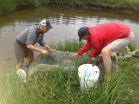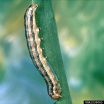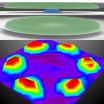(Press-News.org) WASHINGTON, D.C. - Two or more serious hits to the head within days of each other can interfere with the brain's ability to use sugar - its primary energy source - to repair cells damaged by the injuries, new research suggests.
The brain's ability to use energy is critical after an injury. In animal studies, Ohio State University scientists have shown that brain cells ramp up their energy use six days after a concussion to recover from the damage. If a second injury occurs before that surge of energy use starts, the brain loses its best chance to recover.
In mice, the lack of energy use for recovery led to inflammation, degeneration of brain cell segments and problems with learning and memory.
In new work presented Sunday (11/16) at Neuroscience 2014, the annual meeting of the Society for Neuroscience, these same scientists have observed that even if the required glucose is present in the brain, faulty insulin signals in an injured brain don't allow cells to take up the sugar and use it.
All clinical signs suggest that two head injuries close together are dangerous and can even be deadly. But the science behind what's actually going on in the brain is still unclear - and knowing these details could help in deciding when to return athletes to play or military members to service, said lead author Zachary Weil, assistant professor of neuroscience at Ohio State.
"Lots of data show that if two head injuries occur close together, it's not like 1 plus 1. It's more like 1 plus 10," Weil said. "So our goals are to understand what it is about injuries close together that makes us more vulnerable, and can we eventually use some sort of biological signal to tell when it's safe to go back?"
Weil said the discovery that insulin resistance plays a role in brain recovery after injury could also help explain the development of a brain disease seen in professional athletes who have had multiple traumas to the head - chronic traumatic encephalopathy, or CTE. Several CTE symptoms resemble Alzheimer's disease - memory problems, disorientation and trouble concentrating - and the link between defective insulin signals and Alzheimer's is already established.
"With injury, the damaged cells are not able to use energy even though they need it and the glucose is there. It appears that's because the signals are messed up," he said. "It's the same thing seen in Alzheimer's patients. Cells are chronically undernourished even though the sugar level might be high."
In earlier animal studies, Weil and colleagues compared the effects of head injuries that occurred either three days or 20 days apart. Of all the animals, the mice injured three days apart had higher inflammation in the brain, more degeneration of axons - the long, slender extension of the nerve cell body - and problems learning how to navigate a maze and remembering the lessons they did manage to learn. Neurons need healthy axons to communicate with each other.
Mice with a single injury or head blows 20 days apart both showed the surge in brain energy use six days after the injury. The brains in mice injured three days apart never developed such a high level of glucose use.
"With the second injury, demands for energy might outstrip the ability of the damaged cells to actually use the energy," Weil said.
This research was published in a recent issue of the journal Neurobiology of Disease.
In follow-up work presented at the Society for Neuroscience, the researchers examined brain tissue in mice that had experienced no injury, one concussion or two head injures 24 hours apart. After treating the tissue with insulin, the scientists measured activation levels of a key protein in the insulin signaling process. In mice with no injury, the protein activation was increased by the presence of insulin. But the injured brains did not respond to the presence of insulin at all. Without activation of those signals, brain cells have no way to make use of their glucose energy source.
"This means that traumatic brain injury induces insulin resistance in the brain," Weil said. "So we need to work on finding ways to acutely increase insulin sensitivity rather than increasing the actual amount of insulin in the brain."
Weil conducted the research with co-authors Kristopher Gaier and Kate Karelina, both of Ohio State's Department of Neuroscience.
INFORMATION:
Contact: Zachary Weil, 614-292-3489; Zachary.Weil@osumc.edu
Written by Emily Caldwell, 614-292-8310; Caldwell.151@osu.edu
(To reach Weil during the Society for Neuroscience meeting, send him an email or call Emily Caldwell at 614-893-4261.)
Scientific Presentation: 8:15 to 8:30 a.m. Nov. 16, Washington Convention Center Room 150B, Symposium 113.02, "Brain: Cellular and molecular mechanisms"
Mikhail Kosiborod, M.D., of Saint Luke's Mid America Heart Institute, Kansas City, and colleagues evaluated the efficacy and safety of the drug zirconium cyclosilicate in patients with hyperkalemia (higher than normal potassium levels). The study appears in JAMA and is being released to coincide with its presentation at the American Heart Association's Scientific Sessions 2014.
Hyperkalemia is a common electrolyte disorder which can cause potentially life-threatening cardiac arrhythmias and is associated with chronic kidney disease, heart failure, and diabetes mellitus. ...
BLOOMINGTON, Ind. -- An Indiana University-Dartmouth College team has identified genes and regulatory patterns that allow some organisms to alter their body form in response to environmental change.
Understanding how an organism adopts a new function to thrive in a changing environment has implications for molecular evolution and many areas of science including climate change and medicine, especially in regeneration and wound healing.
The study, which appears in the journal Molecular Biology and Evolution, provides insight into phenotypic plasticity, a phenomenon that ...
November 17, 2014, PORTLAND, Ore. -- People who received automated reminders were more likely to refill their blood pressure and cholesterol medications, according to a study published today in a special issue of the American Journal of Managed Care.
The study, which included more than 21,000 Kaiser Permanente members, found that the average improvement in medication adherence was only about 2 percentage points, but the authors say that in a large population, even small changes can make a big difference.
"This small jump might not mean a lot to an individual patient, ...
This news release is available in Spanish.
Although maize was originally domesticated in Mexico, the country's average yield per hectare is 38% below the world's average. In fact, Mexico imports 30% of its maize from foreign sources to keep up with internal demand.
To combat insect pests, Mexican farmers rely primarily on chemical insecticides. Approximately 3,000 tons of active ingredient are used each year just to manage the fall armyworm (Spodoptera frugiperda), in addition to even more chemicals used to control other pests such as the corn earworm (Helicoverpa ...
In the aquatic environment, suction feeding is far more common than biting as a way to capture prey. A new study shows that the evolution of biting behavior in eels led to a remarkable diversification of skull shapes, indicating that the skull shapes of most fish are limited by the structural requirements for suction feeding.
"When you look at the skulls of biters, the diversity is astounding compared to suction feeders," said Rita Mehta, assistant professor of ecology and evolutionary biology at UC Santa Cruz.
With more than 800 species, including both suction feeders ...
For the first time, scientists have vividly mapped the shapes and textures of high-order modes of Brownian motions--in this case, the collective macroscopic movement of molecules in microdisk resonators--researchers at Case Western Reserve University report.
To do this, they used a record-setting scanning optical interferometry technique, described in a study published today in the journal Nature Communications.
The new technology holds promise for multimodal sensing and signal processing, and to develop optical coding for computing and other information-processing ...
Chronic myeloid leukemia develops when a gene mutates and causes an enzyme to become hyperactive, causing blood-forming stem cells in the bone marrow to grow rapidly into abnormal cells. The enzyme, Abl-kinase, is a member of the "kinase" family of enzymes, which serve as an "on" or "off" switch for many functions in our cells. In chronic myeloid leukemia, the hyperactive Abl-kinase is targeted with drugs that bind to a specific part of the enzyme and block it, aiming to ultimately kill the fast-growing cancer cell. However, treatments are often limited by the fact that ...
One of the key reasons the Ebola outbreak got out of control in West Africa in the early days of the crisis was a lack of trust among community members, frontline health workers and the broader health system, suggests new Johns Hopkins Bloomberg School of Public Health research.
Had the citizens and their health care community developed a trusting relationship prior to the outbreak, important messages about the disease and how to stop its spread would likely have gotten through to people much sooner and slowed the march of Ebola, says Timothy Roberton, MPH, MA, a DrPH ...
People who frequently cook meals at home eat healthier and consume fewer calories than those who cook less, according to new Johns Hopkins Bloomberg School of Public Health research.
"When people cook most of their meals at home, they consume fewer carbohydrates, less sugar and less fat than those who cook less or not at all - even if they are not trying to lose weight," says Julia A. Wolfson, MPP, a CLF-Lerner Fellow at the Johns Hopkins Center for a Livable Future and lead author of the study.
The findings also suggest that those who frequently cooked at home - six-to-seven ...
You can offer young children healthier food choices in the elementary school cafeteria, but will they actually put it on their trays and eat it?
Probably not, suggests a new Johns Hopkins Bloomberg School of Public Health study.
Researchers observed 274 children in kindergarten through second grade in 10 New York City public schools as they selected from the offerings during one lunch period when a chicken-and-vegetable entrée was on the menu. They watched to see whether each of the six-through-eight-year-olds chose a fruit, vegetable, whole grain, low-fat milk ...


